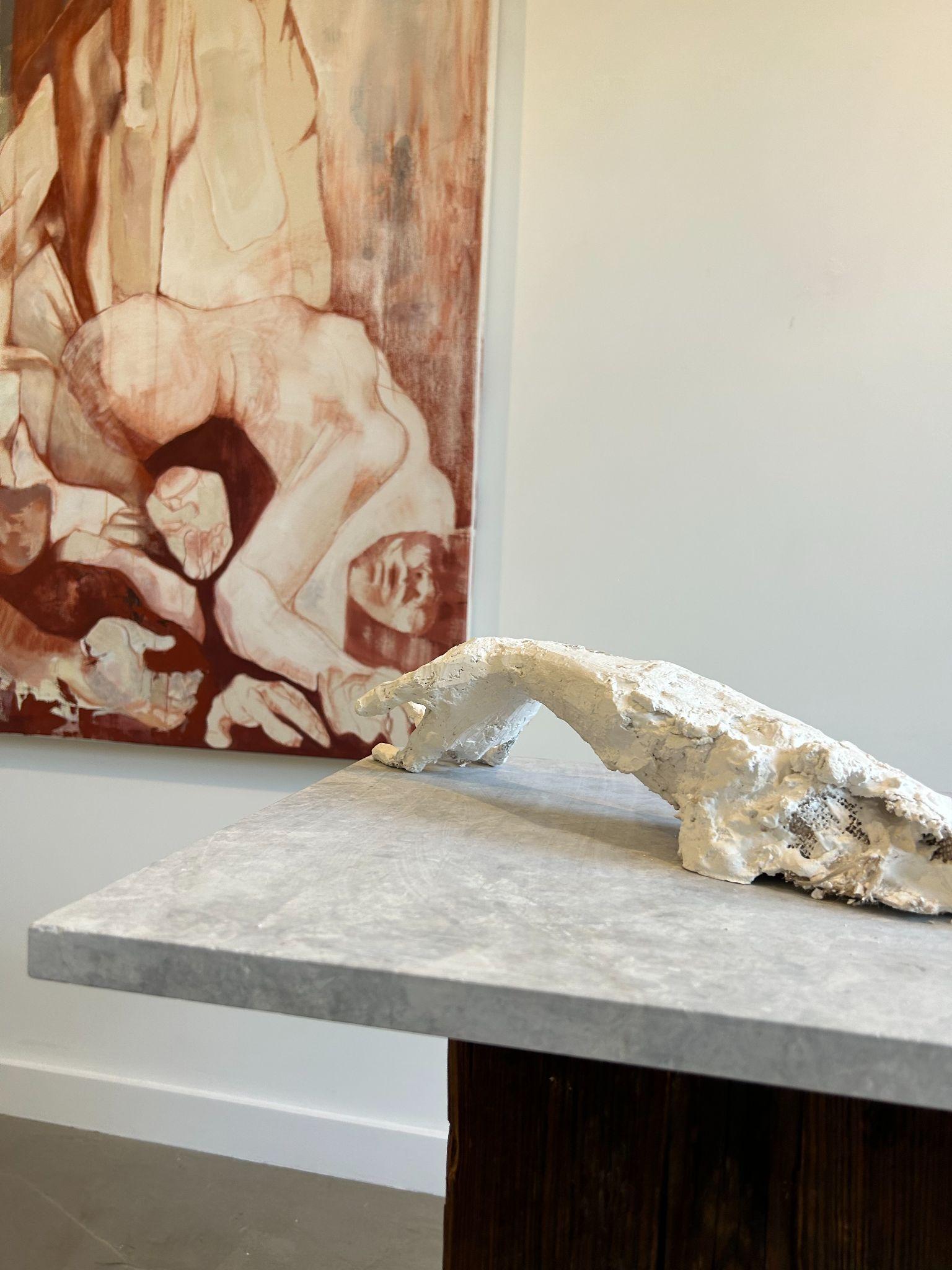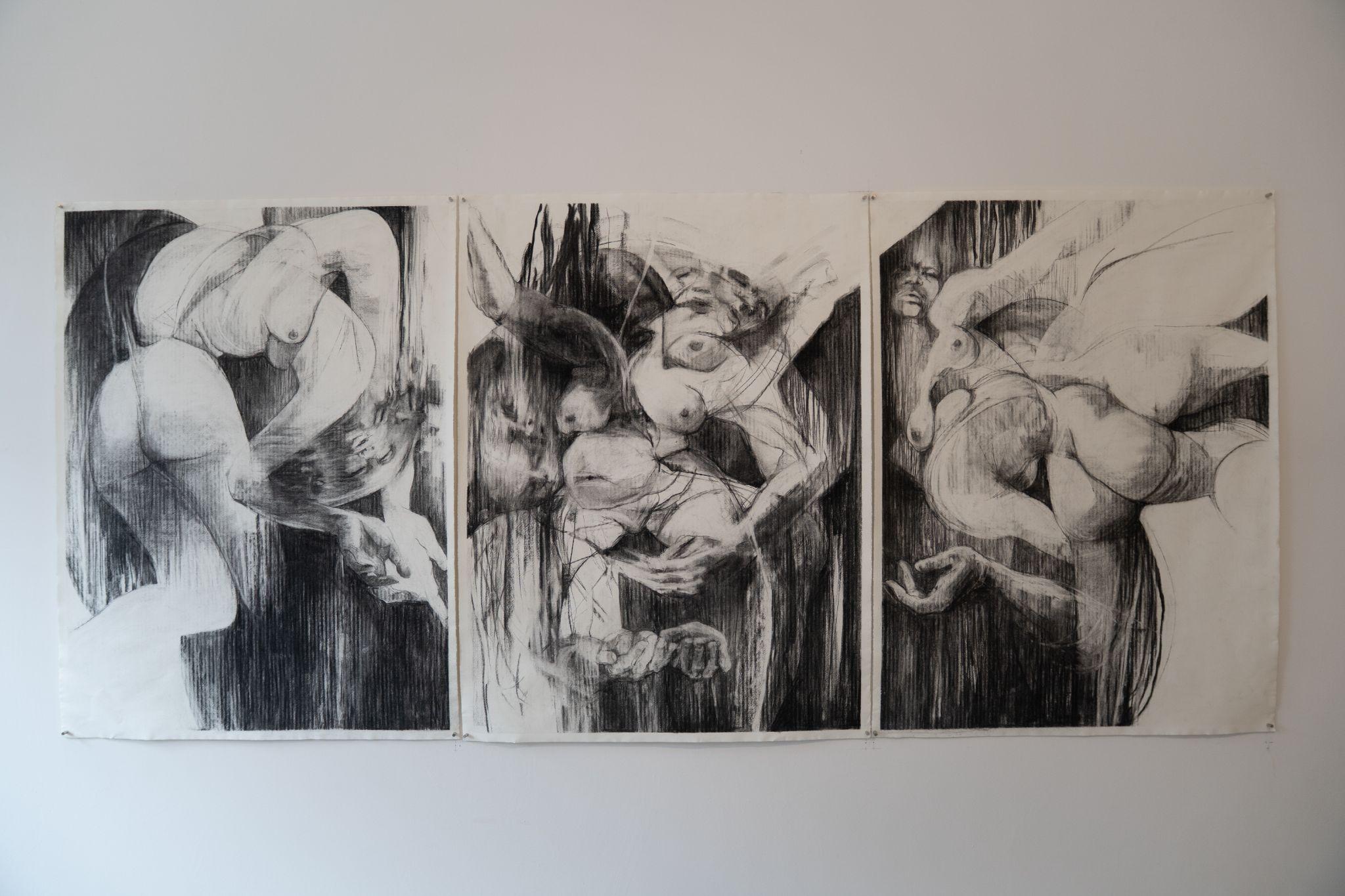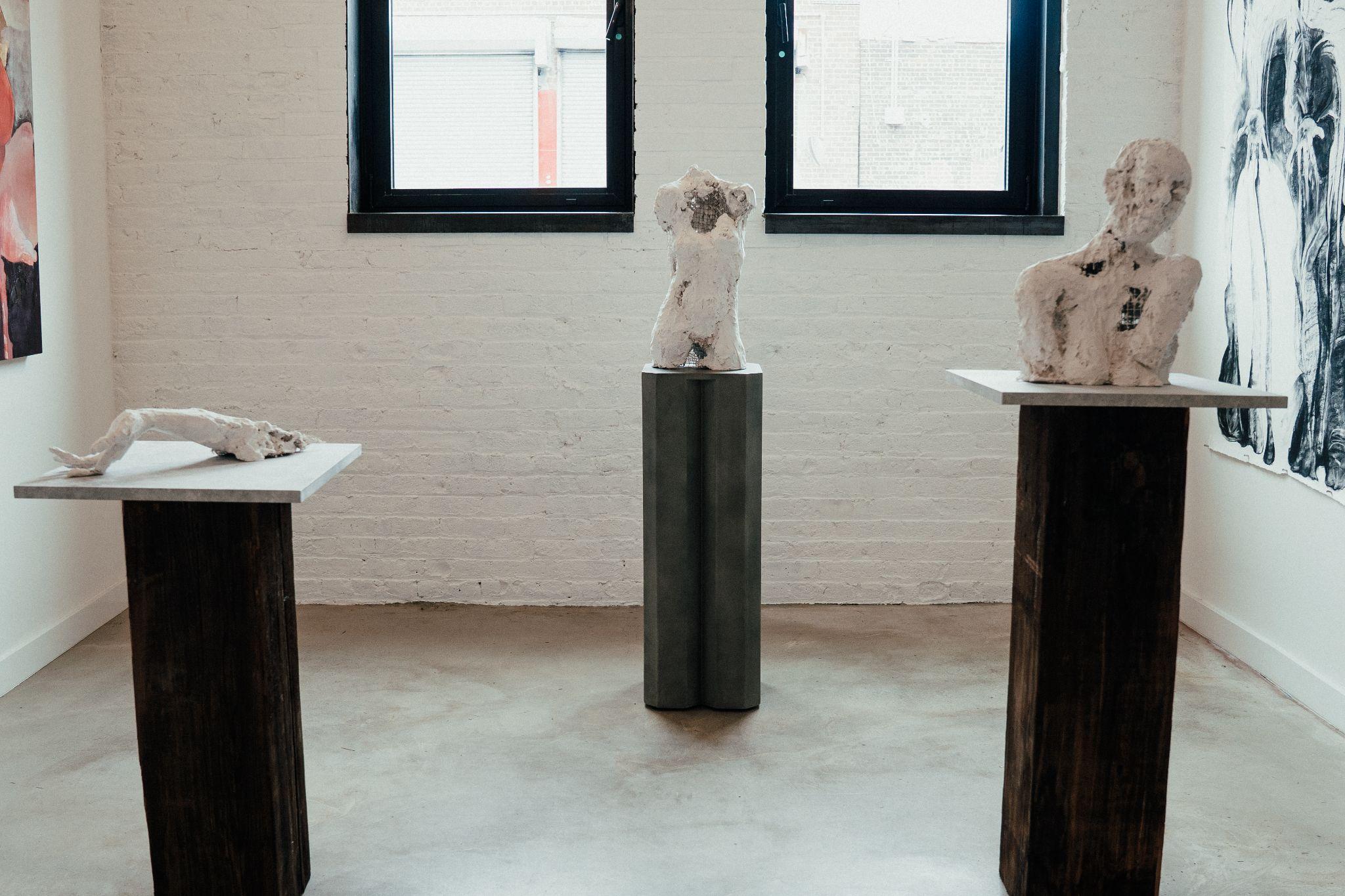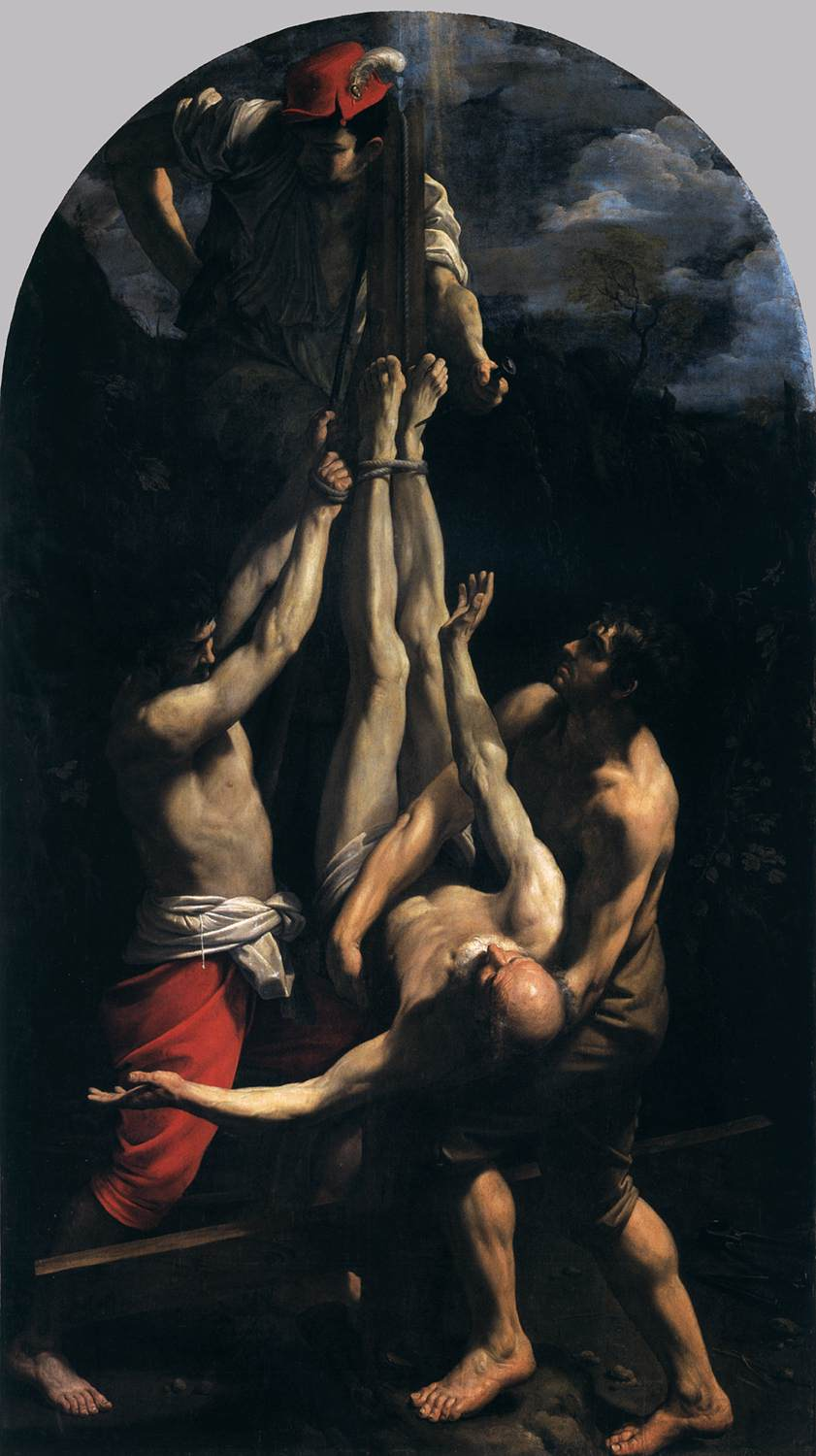La Petite Mort on the Cross: Astrid Garcia’s ‘Ecstatic Schisms’


It’s the summer’s sweat dripping away; September’s mouth agape in anticipation. You feel the bodies writhe as spirits ascend from tangled flesh, searching for their god. Momentarily, they slip out of their skin, leaving their hollow backs arched, fingers curled. They plummet back into the body, like a diver meeting their reflection at the waterline. When the body starts convulsing, contorting, and collapsing into its own caverns, you’ve found it—that which the French call la petite mort, a little death. The razor-thin line between agony and ecstasy. It is in that brief moment of disembodiment, that shift from divinity to carnality that we find Astrid Garcia’s Ecstatic Schisms.

Garcia’s solo exhibition at theNextWave Gallery infuses the latent eroticism of the human form with questions of humility, worship, and fetish. As Garcia casts her curiosities upon her materials, curator A.E Chapman paints with distance, weaving narratives through the physical space of the gallery. Throughout Ecstatic Schisms, Garcia’s figures reject stagnation, and worm their way out of sensibility. They rapidly disappear from the surface, reemerging with a lustful momentum.
Upon entry, the viewer is confronted by a holy trinity of sorts; three sculptures open towards the entryway like a pair of sheepishly spread legs; a cautious invitation. They stand fragmented and vulnerable– the plaster “flesh” desperately clings to their cold, exposed chickenwire armatures. Situated precariously close to one another (on account of the gallery’s limited floorspace), a dismembered forearm (Extremity, 2025), a contrappostoid torso (Below the Neck, 2025), and an unassertive bust (Between the Shoulders, 2025) mark the vertices of the trinity, forming a triangle.

Extremity’s wiry fingers mirror a Christlike blessing, as though it was lifted out of a Byzantine icon. Together, these three sculptures form a holy trinity, the bust is the father, the arm is the son, and the torso is the holy spirit. Visible tactility— drops of smooth plaster are immortalized atop swishes of sticky, semi-dried plaster. Their varying textures are evidence of the material’s temporal limits, revealing the artist’s dance with the medium. Detached from its godly form and resting at crotch-height, Extremity manages to read as religious, corporeal, and lustful– simultaneously. Meanwhile, its visible cutmarks and fussy edges redirect the viewer’s eye to Garcia’s sanguine oil painting, Humility as a Vice / Petrine Cross. If you can position yourself just right, a new layer of intimacy reveals itself. Here, gestural strokes create serpentine bodies of oil, Garcia renders their hands faithfully, figures that long to be touched. Hands are the visual anchor in Ecstatic Schisms eroticism. The dismembered arm and the crucified figure reach for each other, yearning to transcend their material bounds, à la Michelangelo’s Creation of Adam.
Cupped hands wait in anticipation, while smeared, exasperated hands stretch so far they become webbed. While another set seems to offer a blessing. Once again, Garcia fingers the line of religious and erotic ecstasy. Anticipation and exasperation.
Fetish, in its original colonial 17th-century sense, refers to a venerated object believed to hold religious power, serving as a physical connection to divinity. Catholic reliquaries like the Shroud of Turin, the Crown of Thorns, and even sacramental rosaries are fetishes. We contort language to reflect our realities, wringing out outdated connotations and smoothing it over contemporary contexts. As our lives accelerate exponentially, language too must come with us. By the 19th century, fetish had evolved into its (current) corporeal, erotic context. Still, that etymological tension exists in our understanding of the fetish– the shame often associated with sexual deviance.

Catholics may recognize the weight of experiencing Catholic Guilt, Garcia’s Humility as a Vice / Petrine Cross (2025) investigates humility as a possible response to guilt. The five-foot painting alludes to the Italian master, Guido Reni’s 1605 painting of Saint Peter’s crucifixion. Depicting a pious Saint Peter martyred upside down (upon his request), feeling unworthy of dying in the same manner as Christ, himself. In his final act of ecclesiastical humility (or Catholic Guilt), the saint offers his body to the cross. With his feet nearly breaking through the top of the unstretched canvas, Garcia imagines St. Peter’s contorted body reaching out to the witness. She anthologizes his frenzied motions through twisted torsos, an arched spine, and hands that seem to scramble in search of solid ground; an orgasmic death. No stretch of motion is ignored, it is as though the crucifixion moment was captured frame-by-frame and immediately collapsed upon itself. While Humility as a Vice / Petrine Cross’s mangled figure gasps for air, Garcia twists the knife, imbuing the canvas with a range of reds. I read this decision as figure’s the life-force draining, pooling and drying beneath the venerated body. Like a chronicle of aging blood. Garcia deploys her palette as a weapon to investigate his saintly lore, stating, “Red feels strong, like an assertion, like anti-humility.” She leaves us with a final image in which the figure becomes the Petrine Cross itself.
Garcia’s assertion echoes a sentiment from Richard Brody’s 2014 article, A Great Film Reveals itself in Five Minutes in which he proposes that “Synecdoche is the fundamental experience of art.” Humility as a Vice / Petrine Cross questions whether there is truly honor in humility. Is adopting humility the first step of erasure? Of shrinking the self down, dripping the blood dry, and disappearing from the surface, as the figures in Stability Shifts, Solidity Slips do? If we should follow Brody’s line of thought, then the questions posed by Humility as a Vice / Petrine Cross are the lens through which we can interpret Ecstatic Schisms as a whole. An investigation of the threshold between the godly body and the erotic body. The show feels gummy, like speaking with a mouth full of peanut butter. It is balmy and hazy, like a heat-fatigued walk from the beach, yet packed with sapient tensions.
Astrid Garcia: Ecstatic Schisms, curated by A.E. Chapman is on view at TheNextWave Gallery from August 23 through September 13, 2025.
You Might Also Like
What's Your Reaction?
Amanda SRGE_Lindsay is a Brooklyn-based writer and artist whose work seeks to dignify the abject and highlight our digital absurdity. SRGE_Lindsay specializes in exhibition reviews and cultural analysis, and is a contributing critic for IMPULSE. She holds a BFA in Studio Art and Art History from NYU.

